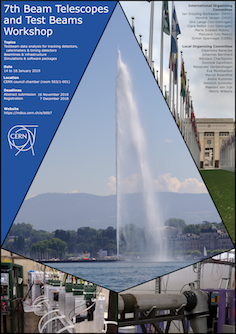Speaker
Description
The upgrade of the LHCb experiment will transform the experiment to a
trigger-less system reading out the full detector at the LHC collision rate and
up to 2×10$^{33}$cm$^{−2}$ s$^{−1}$ instantaneous luminosity. The Vertex Locator (VELO) is the
silicon detector surrounding the interaction region. The upgraded VELO is based
on a hybrid pixel system equipped with data driven electronics and designed to
withstand a radiation dose up to 370 MRad or 8×10$^{15}$ 1 MeV neq cm$^{−2}$. The
detector will be composed of silicon pixel sensors with 55 × 55 μm$^2$ pitch, read
out by the VeloPix ASIC which is being developed based on the TimePix/MediPix
family.
In the upgraded VELO, the ASIC with the highest occupancy is expected to be
crossed on average by 8.5 charged particles in one pp collision event,
corresponding to a peak hit rate of 900 million hits / s. In order to measure
the hit finding efficiency as a function of the track (or particle) rate, a
small beam telescope comprised of five planes of hybrid pixel detectors (200 μm
thick n-on-p silicon sensors with an active area of 1.4×1.4 cm$^{−2}$, bump-bonded
to VeloPix ASICs) was constructed and installed in the high-rate area of the
Fermilab Testbeam Facility. In this talk, first results from this testbeam area
presented.
Timewalk is another important requirement to minimise the number of hits
assigned to a wrong LHC bunch crossing. The most recent results on the VeloPix
timewalk studies will also be shown.




